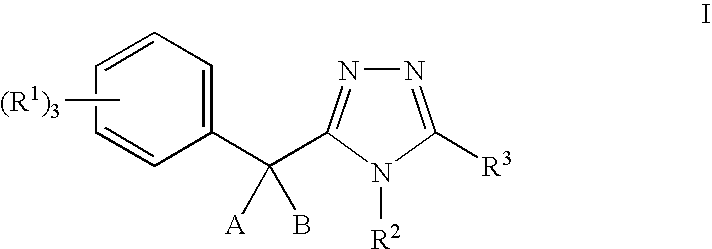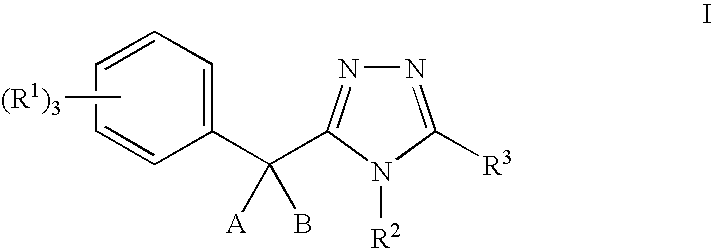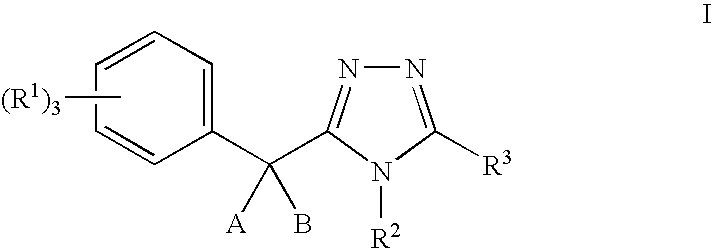11-beta-hydroxysteroid dehydrogenase 1 inhibitors useful for the treatment of diabetes, obesity and dyslipidemia
a technology of steroid dehydrogenase and enzyme, which is applied in the direction of biocide, drug composition, metabolic disorder, etc., can solve the problems of reduced glucose oxidation and glycogen storage in muscle, insufficient activation of glucose uptake, and reduced effect of insulin in stimulating glucose and lipid metabolism in the main insulin-sensitive tissues, namely, liver and adipose tissues
- Summary
- Abstract
- Description
- Claims
- Application Information
AI Technical Summary
Problems solved by technology
Method used
Image
Examples
example 1
[0214]
General SchemeSubstanceAmountMWConc.Mmolesequiv'sS.M. in DMF714 μLN / A0.14 M in DMF0.11TFFH in DMF200 μLN / A0.5 M in DMF0.11Triethylamine in400 μLN / A0.5 M in DMF0.22DMFHydrazine in240 μLN / A0.5 M in DMF0.121.2DMFImino ether A in600 μLN / A0.25 M in DMF0.151.5DMF
[0215]The following synthesis of a 1-D, single, pure compound library was performed on a Myriad Core System. All reaction vessels were dried under a stream of nitrogen at 120° C. for 12 hours prior to use. Solvents were dried over sieves for at least 12 hours prior to use. Reagents and subunits (carboxylic acids and 8-methoxy-2,3,4,5,6,7-hexahydroazocine (imino ether A)) were dissolved in appropriate solvents immediately prior to use.
Synthesis
[0216]The carboxylic acids shown in the table below as starting materials were added to dry, 10 mL fritted Myriad reaction vessels under nitrogen (714 μL, 0.1 mmoles, 0.14 M in N,N-dimethylformamide (DMF)). Fluoro-N,N,N′,N′-tetramethylformamidinium hexafluorophosphate (TFFH) (200 μL, 0....
example 2
Procedure 2A
[0220]
Preparation of 3-trityl-5,6,7,8,9,10-hexahydro[1,2,4]triazolo[4,3-a]azocine (2-1)
[0221]
[0222]Triphenylacetic acid (499.6 mg, 1.73 mmol) was dissolved in N,N-dimethylformamide (DMF, 3.46 mL). Fluoro-N,N,N′,N′-tetramethylformamidinium hexafluorophosphate (TFFH, 460.1 mg, 1.742 mmol) and anhydrous triethylamine (480 μl, 3.44 mmol) were added and the solution was cooled to 0° C. After 10 minutes hydrazine monohydrate (168 μl, 3.46 mmol) was added. The reaction was allowed to warm, and after stirring at room temperature for 30 minutes, it was worked up by adding water and filtering the resulting precipitate. The precipitate was dried under vacuum to give 2,2,2-triphenylacetohydrazide (340.1 mg).
[0223]2,2,2-Triphenylacetohydrazide (48.2 mg, 0.159 mmol) was dissolved in anhydrous toluene (3 mL) and stirred at room temperature under nitrogen. 8-Methoxy-2,3,4,5,6,7-hexahydroazocine (24.7 mg, 0.175 mmole) was added and the solution was stirred at 120° C. overnight and 200° C...
example 3
Procedure 3A
Preparation of 1-(4-chlorophenyl)cyclobutanecarbohydrazide
[0258]
1-(4-Chlorophenyl)cyclobutane carboxylic acid (10.0 g) was dissolved in dichloromethane (150 mL) and cooled to −10° C. in an ice / brine bath. Pyridine (3.84 mL) was added followed by cyanuric fluoride (8.9 mL in 25 mL dichloromethane). After stirring at room temperature for one hour, TLC showed that the reaction was complete. The solution was added to a separatory funnel containing ice (150 mL). After vigorous shaking, the organic layer was removed, dried over magnesium sulfate, filtered and concentrated to give the carbonyl fluoride.
[0259]Anhydrous hydrazine (2.02 mL, 1.4 eq) was dissolved in acetonitrile (100 mL) and cooled to 0° C. Triethylamine (12.8 mL, 2.0 eq.) was added followed by 1-(4-chlorophenyl)cyclobutanecarbonyl fluoride (10 g, 1.0 eq) in acetonitrile (25 mL). After stirring at room temperature for one hour the acetonitrile was removed by evaporation. Product was obtained after silica gel chroma...
PUM
| Property | Measurement | Unit |
|---|---|---|
| Temperature | aaaaa | aaaaa |
| Temperature | aaaaa | aaaaa |
| Temperature | aaaaa | aaaaa |
Abstract
Description
Claims
Application Information
 Login to View More
Login to View More - R&D
- Intellectual Property
- Life Sciences
- Materials
- Tech Scout
- Unparalleled Data Quality
- Higher Quality Content
- 60% Fewer Hallucinations
Browse by: Latest US Patents, China's latest patents, Technical Efficacy Thesaurus, Application Domain, Technology Topic, Popular Technical Reports.
© 2025 PatSnap. All rights reserved.Legal|Privacy policy|Modern Slavery Act Transparency Statement|Sitemap|About US| Contact US: help@patsnap.com



